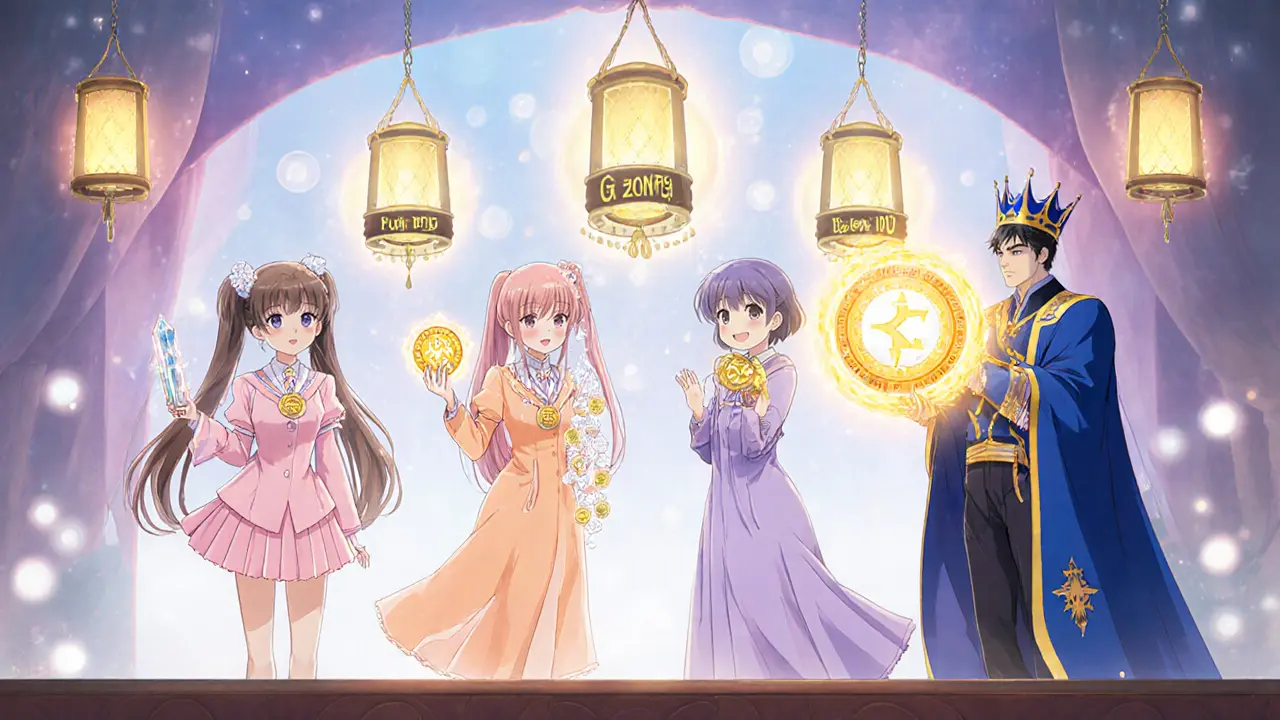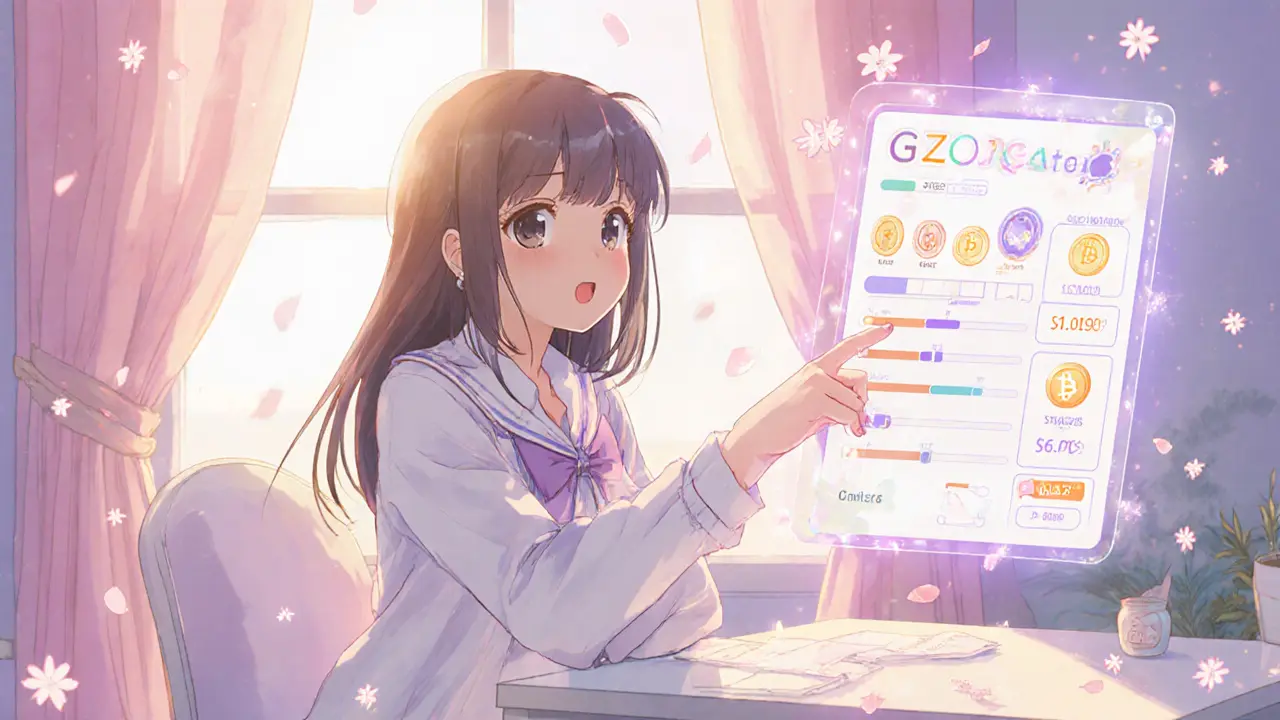GZONE Token Allocation Calculator
Your Allocation Results
When it comes to GameZone is a blockchain gaming launchpad platform that connects gamers and developers through token‑driven IDOs and INOs, the recent GameZone IDO has drawn a lot of questions about token distribution, airdrop mechanics, and future price outlook.
What is GameZone and why it matters
GameZone operates as a metaverse incubator within the BlueZilla ecosystem. Launched in 2021, it aims to democratize access to high‑potential GameFi projects that would otherwise be gated behind large investors. By staking its native GZONE token, users climb a tier‑based allocation system that determines how much of each upcoming launch they can claim.
GZONE token at a glance
The GZONE token is a deflationary utility token with a capped supply of 1billion units. As of October2025 the circulating supply sits around 421.55million, giving a market cap of roughly $1.15million and a price of $0.00274. The token’s economics feature a 7% fee on sell orders: 2% is burned, while 5% is funneled back to stakers as rewards. Early unstaking can incur up to a 25% penalty, encouraging long‑term commitment.
IDO structure - three phases, $1.22million raised
The original IDO was split into three clear segments:
| Phase | Purpose | Capital Raised |
|---|---|---|
| Private Sale | Early backers & strategic partners | $110,000 |
| Public IDO | Community participants via launchpad | $112,500 |
| Strategic Round | Long‑term growth funds & advisory support | $1,000,000 |
This staggered approach gave the project a solid runway while keeping token distribution relatively balanced.
Tier‑based allocation - how staking translates to launch access
GameZone’s allocation model hinges on four tiers. Users lock GZONE tokens for a set period; the more they stake, the higher their pool weight. Tier1 starts at 10,000GZONE, Tier2 at 50,000, Tier3 at 200,000, and Tier4 requires 1millionGZONE. Higher tiers receive larger slices of each IGO’s pool, meaning they can buy more game tokens at the discounted launch price. This system not only rewards commitment but also prevents single whales from snatching the entire offering.
Airdrop mechanics - is there an actual airdrop?
Official records don’t show a one‑time “airdrop” event tied to the IDO. However, the platform’s tokenomics create a continuous “airdrop‑like” flow through staking rewards. The 5% portion of the sell‑fee is automatically distributed to all stakers, proportional to their share of the total stake. In practice, active participants receive regular token drops each time a sell transaction occurs on the market.
Beyond staking, GameZone’s partnership with BlueZilla opens doors to occasional partner‑project rewards. Holders have been eligible for bonus tokens from projects like Katana Inu and Galactic Quadrant when they participated in those IDOs.

Market performance and price outlook
After peaking at $1.18 in November2021, GZONE fell to a low of $0.0036 in March2025. Technical signals show an oversold condition (14‑day RSI 15.6) and moving averages (50‑day SMA $0.012, 200‑day SMA $0.0229) still above the current price, hinting at potential upside if buying pressure returns.
Analysts at crypto.ro project an average price of $1.43 in 2025, with highs near $2.50 if GameZone lands more high‑profile GameFi collaborations. The prediction hinges on three factors:
- Expansion of the tier‑based launch ecosystem, attracting larger game developers.
- Increased utility of GZONE in the GameZone Marketplace for NFT trades.
- Continued support from BlueZilla, bringing fresh funding and advisory resources.
Should the broader crypto market stay bearish, the token could stay under $0.01 for the remainder of 2025, making a strategic accumulation point for long‑term believers.
Key services beyond the token
GameZone isn’t just a token sale platform. It offers a full‑service incubation program that covers legal, marketing, tokenomics design, and technical development for blockchain games. Successful graduates include Velhalla, which saw a 200% price increase during its launch week thanks to GameZone’s promotion.
The GameZone Marketplace lets creators list game NFTs with tier‑based fee discounts, creating another demand source for GZONE tokens.
How to participate in future IDOs and reward streams
- Buy GZONE on a reputable DEX (e.g., PancakeSwap on BSC or QuickSwap on Polygon).
- Stake the tokens in the GameZone staking contract - the UI guides you through tier selection.
- Monitor the launch calendar on the official GameZone site to spot upcoming IGOs.
- Engage in community channels (Discord, Telegram) for early announcements of partner airdrops.
Remember that the early‑unstake penalty can eat into your rewards if you pull out before the minimum lock period, so plan your staking horizon carefully.
Potential risks and mitigation strategies
While the tier system levels the playing field, there are still risks:
- Market volatility: GZONE’s price can swing wildly; keep only what you can afford to lose.
- Liquidity constraints: Smaller DEX pairs may have thin order books, leading to slippage.
- Regulatory uncertainty: Some jurisdictions treat token staking as a security‑like activity.
Mitigate by diversifying across multiple GameFi tokens, using limit orders to control slippage, and staying informed about local crypto regulations.
What to watch for in 2025‑2026
The next 12‑month window could be decisive. Look for:
- New high‑profile game launches that use GameZone’s incubation services.
- BlueZilla‑driven funding rounds that inject fresh capital into the ecosystem.
- Announcements of a dedicated GZONE airdrop campaign - the community often rumors a “seasonal airdrop” tied to milestone achievements.
Keeping an eye on these signals will help you decide whether to increase your stake, stay put, or exit.
Frequently Asked Questions
Did GameZone run a traditional airdrop for GZONE holders?
No one‑time airdrop was announced. The platform’s staking rewards act as a continuous airdrop, distributing a portion of every sell‑fee to active stakers.
How can I increase my allocation for upcoming GameFi IDOs?
Stake more GZONE tokens to move up to a higher tier. Higher tiers receive a larger pool weight, which translates directly into bigger allocation slots during IDOs.
What is the current circulating supply of GZONE?
Approximately 421.55million GZONE tokens are circulating as of October2025, out of a total capped supply of 1billion.
Where can I trade GZONE safely?
The token is listed on several decentralized exchanges such as PancakeSwap (BSC) and QuickSwap (Polygon). Use a reputable wallet and double‑check contract addresses.
Is there a plan for a future GZONE airdrop?
The community often speculates about seasonal airdrops tied to platform milestones. As of now, no official schedule has been released, but staying active in the Discord channel is the best way to catch any announcements.


Joel Poncz
September 26, 2025 AT 17:03Staking those tiers is a real game‑changer.
Kris Roberts
September 27, 2025 AT 20:50Tier‑based staking feels like a leveled‑up loot box, where you throw more GZONE in and hope the loot drops are worth the hype.
It mirrors the classic RPG mechanic of grinding for better gear, only here the gear is allocation weight.
When you hit Tier 3, the multiplier actually doubles what you’d get in Tier 2, which makes the effort feel justified.
The deflationary fee structure also acts like a slow‑burn fire that reduces supply while rewarding loyal players.
What really caught my eye is the continuous “airdrop‑like” flow from sell‑fees – it’s like passive income for gamers.
Even if the market is bearish, those 5% rewards can keep the token’s utility alive.
On the flip side, the early‑unstake penalty can be a sting if you’re not ready to hold long‑term.
It’s a delicate balance between risk and reward, much like deciding whether to invest in a new game prototype.
The market cap being just over $1 million suggests there’s still room to grow if they land big titles.
Technical indicators show an oversold condition, which could be a sweet spot for accumulation.
Analysts are bullish, projecting prices in the $1‑$2 range if the platform expands its game roster.
But remember, crypto volatility can swing wildly; only stake what you can afford to lose.
Liquidity on smaller DEX pairs might cause slippage, so using limit orders is a good habit.
Regulatory uncertainty is another factor – some regions could flag staking as securities.
Overall, the model seems designed to reward patience and community involvement.
lalit g
September 29, 2025 AT 00:37I see the tier system as a peaceful way to level the playing field; it encourages genuine fans to participate without letting whales dominate.
The continuous reward stream feels like a community‑first approach, and that’s something I appreciate.
Reid Priddy
September 30, 2025 AT 04:23Sounds like another pump‑and‑dump scheme hidden behind fancy gamification.
Matt Potter
October 1, 2025 AT 08:10Come on, the tier rewards are legit – it’s a solid way to grow the ecosystem and give early believers a real upside.
Marli Ramos
October 2, 2025 AT 11:57lol this guide is kinda meh 🤷♀️ but the airdrop vibes are cool 😂
Christina Lombardi-Somaschini
October 3, 2025 AT 15:43Dear community, it is noteworthy to acknowledge that the comprehensive nature of the guide provides a substantial framework for prospective participants; however, it would be prudent to emphasize the importance of conducting personal due diligence, especially regarding the inherent risks associated with tokenomics and market volatility. Moreover, the exposition of tier‑based allocations could benefit from clearer illustrations pertaining to the incremental benefits; this would assist novices in visualizing the potential returns vis‑à‑vis their staked amounts. Lastly, a reminder to monitor the evolving regulatory landscape is advisable.
katie sears
October 4, 2025 AT 19:30Indeed, the articulation above is commendable. In addition, one might consider the cultural significance of fostering inclusive participation across diverse gaming communities; such an approach not only democratizes access but also enriches the ecosystem with varied creative inputs. It is essential, therefore, that future updates incorporate multilingual resources to broaden outreach.
Gaurav Joshi
October 5, 2025 AT 23:17One must note that the risk of over‑exposure is real and caution is imperative.
Kathryn Moore
October 7, 2025 AT 03:03Actually the data shows supply is deflationary.
Christine Wray
October 8, 2025 AT 06:50The tier system feels balanced, giving both small holders and whales a fair slice of the IDO pie.
roshan nair
October 9, 2025 AT 10:37From a technical standpoint, the fee‑redistribution model functions akin to a dividend system, rewarding long‑term stakers with a proportionate share of market activity.
The 2% burn further tightens supply, potentially supporting price appreciation if demand holds steady.
In practice, you’ll see periodic spikes in wallet balances coinciding with large sell events, which is a clear indicator of the reward mechanism at work.
For developers eyeing GameZone’s incubation services, aligning token utility with marketplace NFT fees creates a virtuous cycle that can enhance liquidity.
Overall, the design is quite robust, though execution will hinge on community participation and consistent game launches.
Jay K
October 10, 2025 AT 14:23I appreciate the thorough explanation; it affirms the importance of strategic planning when allocating stake.
Kimberly M
October 11, 2025 AT 18:10Nice summary 😊
Navneet kaur
October 12, 2025 AT 21:57Honestly you should just dump all that GZONE now, why bother with staking?